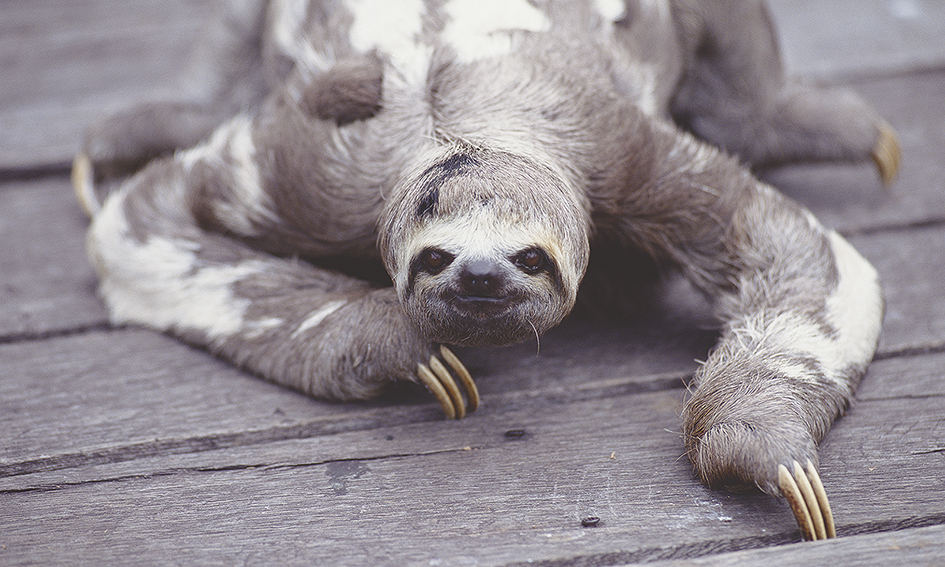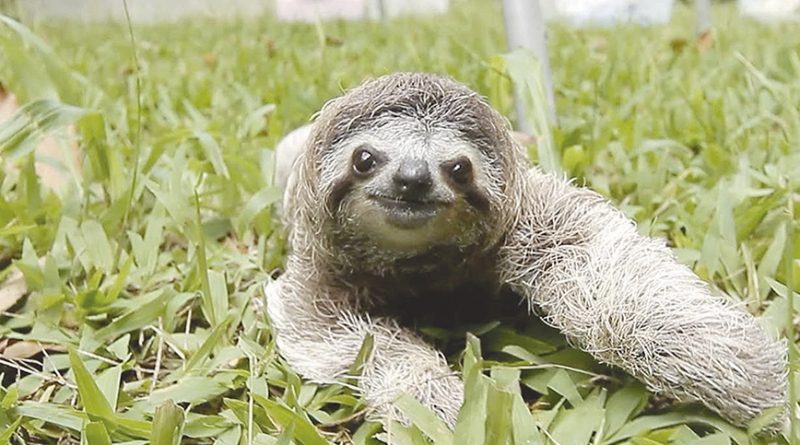¿Por qué los perezos se mueven tan despacio? / WHY DO SLOTHS MOVE SO SLOWLY?
Si los perezosos no hubieran terminado viviendo en un ambiente cálido y húmedo cubierto de árboles, podrían vivir a un ritmo más rápido. Pero a lo largo de innumerables generaciones han alcanzado un ritmo de vida perfectamente adecuado a su entorno.
Los perezosos, como su nombre indica, tienen poca necesidad de apresurarse.
La mayor parte del tiempo viven en lo alto de las ramas de bosques que se extienden a través de Centroamérica y Sudámerica, y solo bajan al suelo para defecar.
Sin duda, llevan una vida en cámara lenta.
Pero ¿sabías que la razón por la que los perezosos se mueven tan despacio se debe a algunos peculiares trucos en su evolución?
Dieta baja en calorías
Los perezosos modernos (el perezoso de tres dedos y el de dos dedos) son versiones mucho más pequeñas de los que vivían en el mundo prehistórico.
Aquellos perezosos gigantes, que pesarían hasta varias toneladas, vivieron durante la última glaciación hasta hace unos 11.000 años y se alimentaban de hojas de los árboles, apoyándose sobre sus patas traseras para alcanzar el follaje.
“Lo que cambió fue su necesidad de subir a los árboles, al tener una dieta basada casi exclusivamente en hojas”, dice Camila Mazzoni, del Instituto Leibniz para el Zoológico y la Investigación de la Vida Silvestre de Berlín, Alemania.
“La dieta a base de hojas es muy pobre en nutrientes y la ingesta de calorías es muy baja. Debido a esto, deben tener una tasa metabólica muy lenta para hacer frente a esta ingesta baja en calorías”, explica.
Regulación térmica
Parte de esto se explica por el lugar donde viven las seis especies de perezosos: en los bosques tropicales.
Son ambientes cálidos y húmedos donde las ventajas normales de un sistema endotérmico (el que permite a los mamíferos regular internamente la temperatura de su cuerpo) no son realmente necesarias: el ambiente ya está tibio, por lo que los perezosos no tienen que gastar gran cantidad de energía para mantenerse calientes.
Al abandonar los rasgos endotérmicos que la evolución les ha regalado a los mamíferos, los perezosos han adoptado un estilo de vida lento que les permite ahorrar energía más similar a los animales de sangre fría como los reptiles.
“La regulación térmica que tienen que hacer la mayoría de mamíferos requiere mucha energía”, dice Mazzoni. “Pero como los perezosos no deben hacerla, necesitan mucha menos”.
“Esto significa que solo pueden vivir en los trópicos y no en las montañas, donde la temperatura disminuye bastante. Sin embargo, el perezoso de dos dedos es un poco más flexible y asciende un poco más arriba en las montañas en Costa Rica”, agrega.
La experta señala que los perezosos a menudo “suben a lo alto de la copa del árbol por la mañana para obtener algo de energía del sol y, cuando hace mucho calor, vuelven a la sombra de los árboles”.
Este comportamiento es mucho más típico de los animales de sangre fría que de los mamíferos.
El ciclo de vida arbóreo de los perezosos significa que pasan muy poco tiempo bajo la amenaza de depredadores como el jaguar. Esta es otra razón por la que las reacciones rápidas y la enorme cantidad de energía que requieren, simplemente, no les son necesarias.
Algas y hongos
Si miras de cerca a un perezoso y su pelaje notarás que tiene un tono verde a causa del musgo y algas de los árboles en los que vive.
“Su cabello está modificado para que las algas y los hongos pueden crecer”, indica Mazzoni. “Sabemos que hay algún tipo de relación simbiótica”.
¿Para qué son buenas estas algas? Muchos científicos están tratando de responder a esta pregunta. “Podrían ser buenas para el camuflaje de los perezosos”, dice Mazzoni. Las algas verdes y los hongos podrían ayudar a los perezosos a mezclarse y difuminarse con el fondo del bosque.
“También podría ser una forma para que los perezosos obtengan proteínas adicionales”, afirma, y detalla que se ha visto a algunos perezosos lamiendo las algas que crecen en su pelaje.
Los hongos también pueden ayudar a mantener baja su cantidad de parásitos. “Su pelaje es casi completamente resistente al agua e impide muchos parásitos. Los perezosos tienen menos parásitos que otros mamíferos de un tamaño similar”.
Gotas de leche
Becky Cliffe, zoóloga británica que trabaja en la Fundación para la Conservación de Perezosos de Costa Rica, dice que solo cuando ves a los perezosos en la naturaleza te das realmente cuenta de lo lentos que son.
“Sabes que se mueven lentamente, pero luego miras cada parte de su cuerpo, cuando giran la cabeza, o incluso cuando parpadean y todo lo hacen muy lentamente”, comenta.
Otra de las características de los mamíferos de la que los perezosos han prescindido es la cantidad de leche que las madres lactantes producen para sus crías.
“Las madres perezosas no almacenan grandes cantidades de leche, sino que les sale gota a gota”, dice Cliffe. Las crías se mantienen cerca del pezón y se alimentan a medida que la leche gotea.
Los años de Cliffe observando perezosos en la jungla costarricense le han dado mucha información sobre su comportamiento.
“No saltan ni corren. Pero tienen los brazos más fuertes. Si un humano y un perezoso tuvieran que medir fuerzas con los brazos, el perezoso ganaría sin duda”, asegura.
Pero las patas del perezoso, que nunca se ven en la obligación de alcanzar una velocidad vertiginosa ni de soportar todo el peso del animal, no tienen la misma masa muscular.
Sin embargo, la motivación de la vida del perezoso no debe confundirse con la pereza, dice Cliffe. “No son vagos. Los monos aulladores que viven en los bosques duermen hasta 18 horas al día, y los perezosos solo duermen alrededor de 10”.

ENGLISH
Had sloths not ended up living in a hot, humid environment covered in trees, they might be sprightlier, living at a quicker pace. But over countless generations they have arrived at a pace of life perfectly suited to their environment.
Sloths, as their name betrays, have little need to rush. For the most part, they live high in the branches of the forests which stretch across Central and South America, only coming down to the ground to defecate. And the life they lead is very much in slow motion.
Just why sloths move so slowly is due to some peculiar evolutionary tricks.
Modern-day sloths – the three-toed sloth and the two-toed sloth – are much smaller versions of the sloths that inhabited the prehistoric world. Giant sloths, some that would weigh up to several tonnes, walked on the ground during the last ice age until around 11,000 years ago, foraging from the trees by standing up on their hind legs to reach into the foliage.
“What changed was a combination of both going up into the trees, and having a diet almost entirely based on leaves,” says Camila Mazzoni of the Leibniz Institute for Zoo and Wildlife Research in Germany.
“The leaf diet is very poor in nutrients and the intake of calories is very low. Because of this they have to have a very slow metabolic rate to cope with this low calorific intake.”
All six species of sloths live in tropical forests. It’s a hot and humid environment that means some of the normal advantages of an endothermic system aren’t really required – the environment’s already warm, so you don’t have to expend an enormous amount of energy to keep your muscles and cardiovascular system warm. So sloths don’t.
Being a mammal has its benefits. Capable of regulating their body temperature internally, they can live in colder climates – much colder than reptiles or other cold-blooded animals.
But this hot-blooded evolutional trick has a few drawbacks as well. In order to fuel this energy-hungry system, mammals need to eat a lot and often to keep the muscles needed for movement warm. It’s why mammals can still dart about on a cool day, while lizards remain sluggish – if they move at all.
This endothermic adaptation has allowed mammals to colonise most of the environments on Earth – including the freezing cold expanses of both poles.
But elsewhere, some mammals have abandoned the endothermic traits that evolution has gifted them. In doing so, they’ve adopted a go-slow, energy-saving lifestyle more similar to cold-blooded animals.
“The thermo-regulation that most mammals have to do requires a lot of energy,” says Mazzoni. “But because sloths don’t have it, it means they require a lot less energy.
“But this means they can only live in the tropics, and not high up in the mountains where the temperature gets quite low. Having said that, the two-toed sloth is a bit more flexible, and will go a bit higher into the mountains in Costa Rica.
The sloths’ tree-based life cycle means they spend very little time at risk from predators like the jaguar. This is another reason why lightning-fast reactions – and the enormous amount of energy needed to fuel them – just aren’t needed. “They have this intimate relationship with the trees,” says Mazzoni. “They depend on them.”
She says sloths often “go up to the top of the canopy in the morning to get some energy from the Sun and when it gets really hot they go back down to the shade of the trees”. This behaviour is much more typical of cold-blooded animals – lizards and other reptiles – than it is of other mammals.
Look closely at a sloth and its fur will often also have a green shade to it. It might be tempting to assume that the animals have become so sedentary that they have become home to moss and algae from the trees around them. But this misses something far more fascinating, says Mazzoni.
“Their hair is modified and has these kind of openings in which the algae and fungi can grow,” she says. “It’s not because they’re slow. We know there’s some kind of symbiotic relationship going on there.”
What are these algae good for? Many scientists are trying to figure that out. “It could be that it’s good for the sloths’ camouflage,” adds Mazzoni. The green algae and fungi could help sloths blend in to the background of the forest canopy.
“It could also be a way for the sloths to get extra protein,” she says, noting that sloths have sometimes been seen to lick the algae growing on their fur.
Cliffe’s years watching sloths in the Costa Rican jungle has given her much insight into their behaviour. “They don’t jump and they don’t run. But they do have the most incredibly strong arms. If a human and a sloth had an arms wrestle, the sloth would definitely win.” But the sloth’s legs – which aren’t needed for breakneck speed or even supporting their full weight most of the time – don’t have the same muscle mass.
The sloth’s steady-as-you-go approach to life shouldn’t be mistaken for laziness, however, says Cliffe. “They’re not lazy. The howler monkeys that live in the forests sleep for up to 18 hours a day, and the sloths only sleep for around 10.”


 (1) (2).jpg)


Debe estar conectado para enviar un comentario.